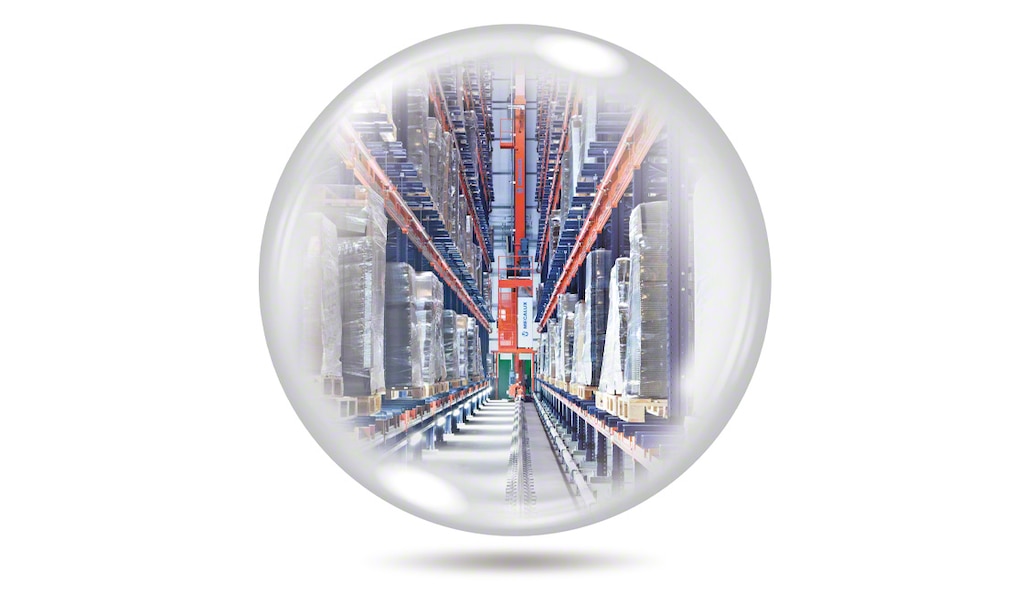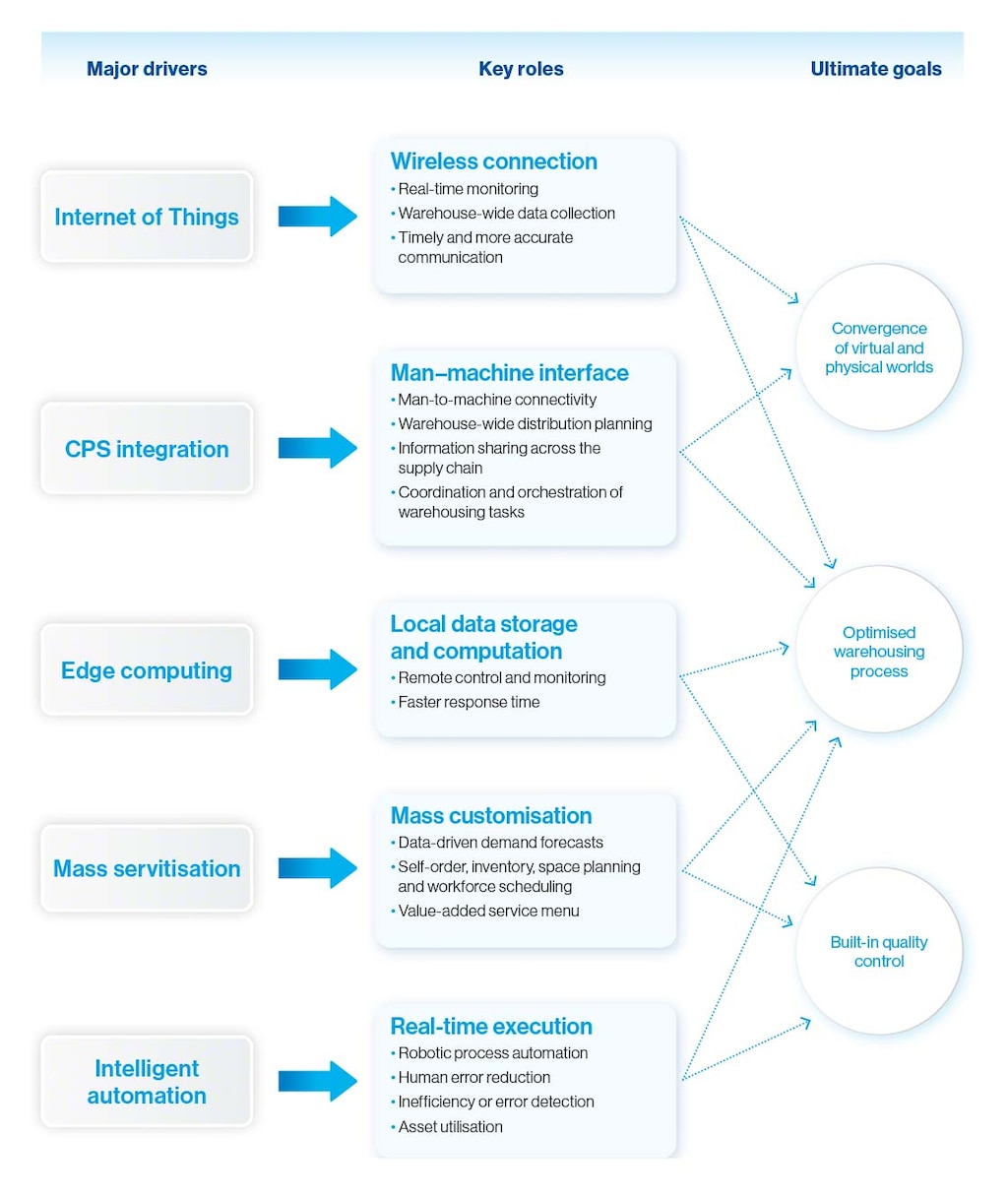Warehouse technologies hold great potential to ramp up business performance. A recent research paper by the Schmidthorst College of Business (Ohio) shows the advantages of integrating cutting-edge solutions into logistics processes. “With the rapid advances in digital technology and the widespread adoption of Industry 4.0, many companies view smart warehousing as the wave of the future,” says Professor Hokey Min, author of the study and an expert in global logistics strategy.
In logistics facilities, automation and digital technologies enhance efficiency and reduce the time it takes to serve customers. “A smart warehouse that exploits intelligent equipment with machine-learning capabilities can bring numerous benefits to operations,” says Min.

The research findings, published in the journal Logistics, identify five key advantages of using technologies like the Internet of Things, warehouse management systems and collaborative robots in logistics facilities:
1. Streamlined inventory levels via supply chain visibility
Smart technologies can help businesses prevent excess inventory to better adjust to market changes and meet customer demand. Machine-learning systems improve supply chain visibility, allowing warehouse managers to see all potential bottlenecks well in advance and take corrective action.
“For example, suppose inventory errors or delayed order picks are detected. With technology, warehousing workers can immediately figure out where they originated and can act before the problems become worse,” says Min.
2. Improved warehousing agility and customer response time
Automation and real-time monitoring enable quick error detection and correction, enhancing the speed and quality of service. In smart warehouses, the use of software as a service (SaaS) can also eliminate the need for time-consuming, on-premise updates by performing these on the fly.
3. Enhanced labour productivity
Automation minimises human intervention in routine tasks, freeing up time for more value-added activities. “Warehouse automation limits the need for on-site staff and helps companies better prepare for the busiest times of the year, such as Black Friday and Christmas holidays. It also reduces the time needed for warehousing workers to complete tasks like order picking, packing and shipping,” says the author.
4. Higher return on assets
Advanced technologies ensure the optimal use of warehousing equipment, which results in increased efficiency and lower operational costs. Warehouse technologies can help organisations gain a competitive advantage and achieve a higher return on assets. In the words of Min, “The benefits of smart warehousing make it an attractive option for companies looking to stay competitive in the evolving business world.”
5. Better service quality control
In smart warehouses, embedded sensors monitor equipment performance and detect anomalies to ensure correct maintenance and service quality control. For example, vibration sensing can give warehouse managers an early warning alert when storage equipment, (automated storage and retrieval systems (AS/RS) and automated guided vehicles (AGVs) require immediate maintenance or repair.
Key drivers of smart warehousing
The research identifies several key drivers for the development of smart warehouses. These include:

Source: Min, Hokey. 2023. "Smart warehousing as a wave of the future". Logistics 7(2): 30.
- Internet of Things. In tech-driven facilities, the IoT connects physical objects embedded with sensors to different computing devices to “talk” to each other and exchange data over the internet. The sensors provide real-time information within the warehouse network, enabling live control and monitoring of routine activities such as quality inspection, inventory management and space planning.
- Cyber-physical system. At the core of the smart warehouse, the CPS allows for autonomous decision-making. Based on the seamless integration of computation, physical objects and real-time information gathered from the IoT, cyber-physical systems enhance machine-to-machine connectivity and speed up responses to fulfillment errors, inventory needs and safety alerts.
- Edge computing. This technology brings data processing power closer to the facility’s computer network, enabling data storage and computation to be performed locally, albeit in remote locations. Edge computing ensures uninterrupted operations — even in warehouses with limited internet connectivity.
- Mass servitisation. The shift towards mass servitisation in logistics facilities enables organisations to differentiate themselves by offering value-added services. These solutions, built upon AI and business intelligence tools, can help companies provide customised services before shipping products to customers.
- Intelligent automation. In a smart warehouse, robotic systems and human–robot collaboration optimise material flows, reduce human errors and can diagnose process anomalies in real time. Intelligent automation prompts immediate corrective action and suggests procedures or tools to help fix problems instantly.
As the world continues to evolve, smart warehousing is poised to revolutionise the way facilities operate, offering unprecedented efficiency, cost savings and agility in the supply chain. In the words of Min, “Smart warehousing can drive cost-savings and revenue opportunities in today’s volatile business environment.”
Author of the research: Hokey Min, Professor and James R. Good Chair in Global Supply Chain Strategy, Schmidthorst College of Business, Bowling Green State University (Ohio, US).
Original research publication: Min, Hokey. 2023. Smart warehousing as a wave of the future. Logistics 7(2): 30.
